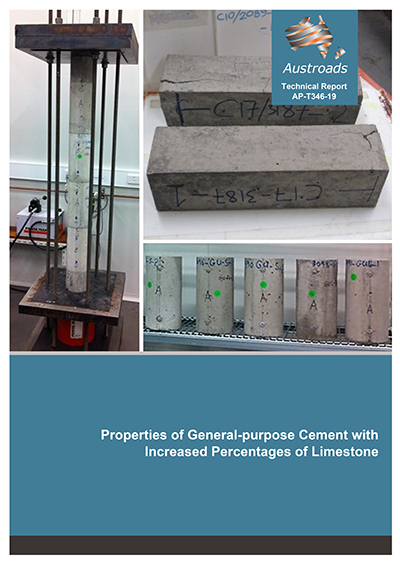Bridges

- Publication no: AP-T346-19
- ISBN: 978-1-925854-41-1
- Published: 11 October 2019
- Edition: 1.1
- PDF (free) Download
This report presents the results of a research project commissioned by Austroads to investigate whether the currently used Australian general-purpose (GP) cement which complies with AS 3972, and which may contain up to 7.5% limestone as a mineral addition, could be replaced with a cement proposed by the cement industry, which would contain 12% limestone, could be justified with respect to performance and durability.
Following a literature review, the project compared the properties of concretes made with a GP cement, containing 2.9% limestone with those of corresponding concretes incorporating the cement with 12% limestone. Both plain cement concretes and concretes incorporating cement blended with fly ash and slag were tested. As the cement industry declined to provide the cements required for this research, two equivalent cements were imported from Canada, designated general use (GU) cement, with 2.9% limestone content, and general use limestone (GUL) cement, with 10% limestone content (increased to 12% in the laboratory).
Physical, mechanical, chemical and microstructural aspects of both concretes were examined.
The study concluded that it would be highly inadvisable to entirely replace the currently used Australian GP cements, made to comply with AS 3972:2010 with up to 7.5% limestone, with the cement proposed by the industry that would contain 12% limestone, without the option of cements of lower limestone content being readily available in the market to all users.
Edition 1.1 corrects minor typographical errors and Tables 5.8 and 5.9.
- Summary
- 1. Introduction
- 2. Scope of Work
- 3. Literature Review
- 3.1 Background to this Project
- 3.2 Published Information
- 3.2.1 Overall Reviews and Standards
- 3.2.2 Properties of Fresh Concrete
- 3.2.3 Cement Hydration
- 3.2.4 Strength Development and Mechanical Properties
- 3.2.5 Durability Properties
- 3.2.6 Influence of Curing at Elevated Temperature on Properties
- 3.2.7 Use of Supplementary Cementitious Materials (SCMs) with Cement Containing Limestone
- 4. Materials
- 4.1 Cement
- 4.2 Limestone
- 4.3 Fly Ash
- 4.4 Slag
- 4.5 Aggregates
- 4.5.1 Fine Aggregate
- 4.5.2 Coarse Aggregate
- 4.6 Superplasticiser
- 5. Mix Proportions and Properties of Mixes
- 5.1 Normal Consistency of Binders
- 5.2 Water Requirement of Mortars
- 5.2.1 Mortar Mixing and Flow Testing
- 5.3 Concrete Trial Mixes
- 5.3.1 Concrete Mixing and Slump Testing
- 5.3.2 Compaction and Curing
- 5.4 Final Concrete Mixes
- 5.5 Concrete Specimens
- 5.6 Curing
- 5.7 Schedule of Tests
- 5.8 Repeating the Concrete Mixing, Specimen Casting and Testing
- 6. Test Results
- 6.1 Compressive Strength
- 6.1.1 Effect of Steam-curing
- 6.1.2 Effect of Cement Type
- 6.1.3 Conclusion
- 6.2 Statistical Analysis of the Strength Results
- 6.2.1 Conclusion
- 6.3 Modulus of Elasticity
- 6.3.1 Stress-strain Behaviour
- 6.3.2 Conclusion
- 6.4 Volume of Permeable Voids (VPV)
- 6.4.1 Conclusion
- 6.5 Resistance to Sulfate Attack
- 6.5.1 Conclusion
- 6.6 Electrical Indication of Concrete's Ability to Resist Chloride Ion Penetration – ASTM C1202
- 6.6.1 Conclusion
- 6.7 Chloride Diffusion Coefficient by ASTM C1556 (NT Build 443) Method
- 6.7.1 Analysis of the Chloride Content Data
- 6.7.2 Conclusion
- 6.8 Carbonation
- 6.8.1 Conclusion
- 6.9 Unrestrained Drying Shrinkage
- 6.9.1 Conclusion
- 6.10 Creep
- 6.10.1 Instantaneous Elastic Modulus (E)
- 6.10.2 Creep Strain
- 6.10.3 Creep Rate
- 6.10.4 Conclusion
- 6.11 Delayed Ettringite Formation (DEF)
- 6.11.1 Conclusion
- 6.12 X-ray Diffraction (XRD) Analysis of Samples
- 6.12.1 Conclusion
- 6.13 SEM/EDX
- 6.13.1 Concrete Mixes made with GU-based Cements and Moist‑cured at 23 °C, 100% RH
- 6.13.2 Concrete Mixes made with GU-based Cements, Initially Steam‑cured at 80 °C
- 6.13.3 Concrete Mixes made with GUL-based Cements and Moist‑cured at 23 °C, 100% RH
- 6.1 Compressive Strength
- 7. Conclusions
- References
- Appendix A Test Results
- Appendix B Volume of Permeable Voids (VPV)
